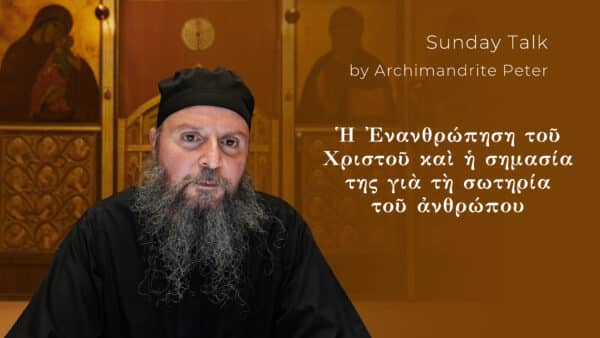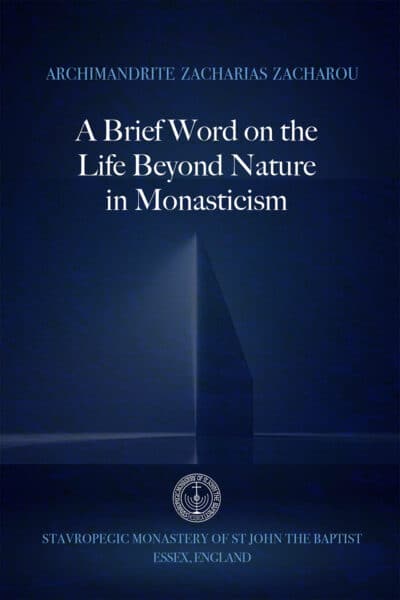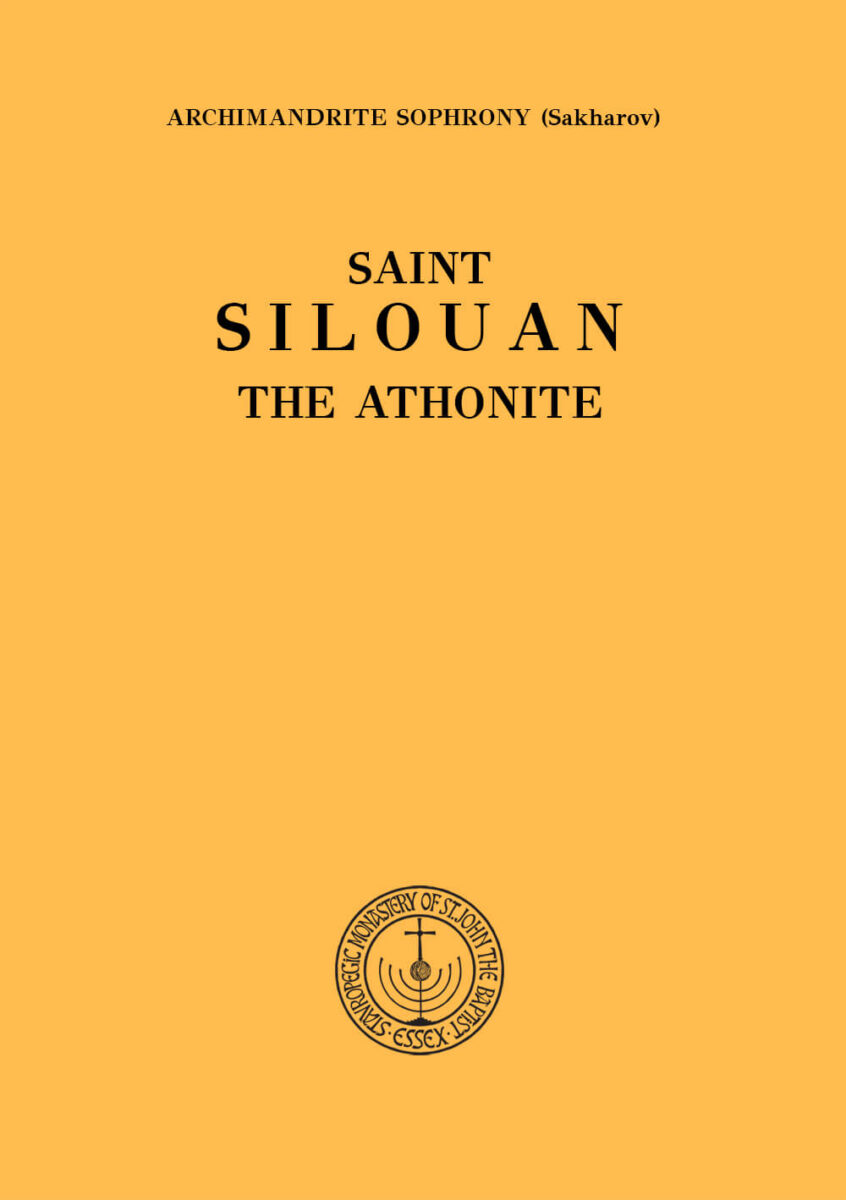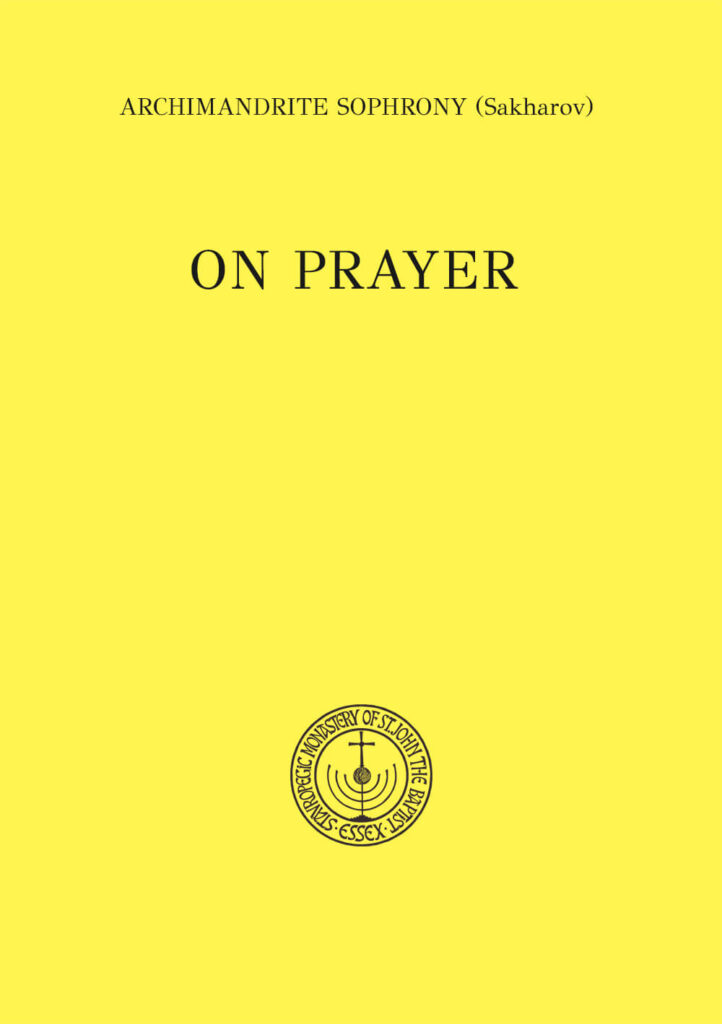Introduction
Divine revelation makes known to us God as the Creator, Who by the energy of His word ‘spake, and it was done; He commanded, and it stood fast’.1Ps. 33:9. The same God fashioned man with especial care, crowned him with glory and honour, and created his heart to be ‘unique’, giving him the power to receive Divine Being within him.
Man can become a co-worker with God by revealing the divine image in his heart and in the hearts of his brethren. The act through which man’s cooperation in the work of his salvation is made manifest, above all, is prayer.
In His eternal Gospel, the Lord testifies that He did not come to earth to minister unto the treacherous peace of this world, but to send ‘a sword and division’.2Matt. 10:34-35. One of the signs of the ‘division’ that the Lord brought into the world is prayer, which, as a mother lifts up her child, raises the soul above the turmoil of the multitude, and frees it from the daily tumult and despondency of the world whereby love grows cold.
In the act of prayer, we strive to unite ourselves with that which transcends our created nature. Therefore, for our world, prayer is a ‘supernatural’ act, and everything natural proves to hinder this work. Sometimes the heart of man becomes dry, the struggle of turning in supplication towards God becomes arduous, and his corruptible body, which has no power to ascend into the sphere of the Spirit, resists or grows weary. However, according to the word of Saint Sophrony the Athonite, we must always strive so that ‘every decrease in the power of prayer may be as short as possible.’
Hesychastic Prayer
The Lord Jesus Christ, through His incarnation, established on earth the holy Body of His Church, and within her bosom He planted monasticism as a holy root, which from the earliest centuries of Christianity to our days has yielded illustrious fruits—our holy and God-bearing Fathers, who have passed down to us the holy path of Hesychasm.
The term hesychia refers to the state of pure prayer, during which the one who prays stands in the presence of God with his mind in his heart. It is then that man is built up into a temple made without hands of Divinity, thus fulfilling his true purpose. By the union of the mind and the heart, he truly finds himself in the innermost depth of his being, and as a mind ‘in the likeness of God,’ as an immortal being, he invisibly beholds God. This contemplation enlarges his heart and enables it to embrace heaven and earth. Then, the ‘true man’ goes forth to his ‘true work’ which is hypostatic prayer and intercession for the whole world. Such prayer is a sign that ‘image’ given to man at creation is being restored within us.
Hesychastic prayer constitutes the heart of the Orthodox ascetic tradition. Hesychasm is the ‘innermost body’ of the Body of the Church; it is the ‘salt of the earth’ and the ‘restraining power’ that preserves the world.
Interpreting the writings of Saint Silouan, Elder Sophrony speaks of two ways of knowing.3Saint Silouan the Athonite, p. 103. According to the first way, the primary means of knowledge is the human mind. In the usual course of science and reason, man’s mind turns outward in order to increase its knowledge. Thus, he inevitably encounters an immeasurable variety of phenomena and information. In his effort to create some kind of unity, even if artificial, the mind resorts to a synthesis that ultimately does not fully correspond to objective and ontological reality.
The second way of knowing is spiritual. This way is fundamentally different from the intellectual way because it understands knowledge as existential communion, as a union ‘in being’.4We Shall
See Him as He Is, p. 230. For Elder Sophrony, the knowledge of God is experienced as ‘communion in being’.5Saint Silouan the Athonite, pp. 112, 217; We Shall See Him as He Is, pp. 128, 176; Truth and Life, p. 35, see also pp. 36, 41 and Ἄσκησις καὶ θεωρία (Greek edition), p. 15. The one who knows enters into an existential communion with the One who is known. Man participates not only with his intellect, but with the fulness of his nature in this act, and thus his integrity is restored.6The Mystery of Christian Life, pp. 18, 222. In other words, this type of knowledge of God differs qualitatively from the knowledge acquired by philosophical thought because, along with spiritual knowledge, a new form of life is imparted to him.7On Prayer, p. 35.
Man may perhaps comprehend with his mind some of the phenomena of this world. However, it is only possible to receive divine revelation ‘in the Holy Spirit’.8Saint Silouan the Athonite, p. 233. The starting point of this search is the acceptance by faith of the testimony and the entire spiritual inheritance of the Prophets and Fathers, who received divine revelation. Faith precedes, being incomparably more subtle, more perfect, and more boundless than the mind.9Striving for Knowledge of God, p. 92. The Lord testifies that if we do not believe in His Divinity and the absolute truth of His words, we will die ‘in our sins’.10John 8:24. Through faith in Christ’s word, the mind enters into the heart, which burns with love for our great Benefactor, and then man acquires great boldness. What appears to the ‘carnal mind’11Col. 2:18. as perfect foolishness is, for the man of faith, wisdom, power, life, and light.12On Prayer, p. 33. See also 1 Cor. 1:18-30.
In this state, knowledge is lifted above earthly things and follows the faith of contemplation. Then ‘faith itself swallows up the knowledge, converts it, and begets it anew, so that it becomes wholly and completely spirit.’13Saint Isaac the Syrian, The Ascetical Homilies, Homily 52, ‘On the third degree of knowledge which is the degree of perfection’, p. 399. This type of knowledge of God, understood as ‘communion in being,’ is the highest aim of the hesychasts.
Saint Silouan the Athonite
The essence of noetic hesychia lies in guarding the heart from every alien influence through internal noetic prayer so that man may stand before God ‘with imageless prayer’.14Saint Silouan the Athonite p. 155. The hesychast has his ‘mind in prayerful attention stationed in the heart’.15Ibid., p. 133. In this difficult and painful struggle, the Lord has compassion on man and ‘runs’ to draw nigh, astonishing the soul with the unexpected and luminous dawn of His grace in the previously ‘arid’ place of the heart.
In hesychastic asceticism, the Christian athlete does not yield to inactivity, but in silence, he experiences the most active state that the human spirit can bear, being strengthened of course by the grace of the Holy Spirit. He struggles to constantly keep his mind in his heart in order to offer pure prayer to God, during which, without knowing whether he is ‘in the body or out of the body’, he detaches himself from the created world. He cleaves only to the Lord and becomes ‘one spirit’ with Him.161 Cor. 6:17. When a man embraces the most holy divine Name, loves it, and invokes it ‘with a pure heart,’171 Tim. 2:22. the Lord Jesus comes to dwell in his heart ‘by faith’.18Eph. 3:17. Then man becomes double. God ceases to be for him an abstract theory. He becomes known and beloved. As Saint Sophrony testifies, to some is given the grace to feel God ‘surrounding them closer than the air they breathe’.19On Prayer, p. 79.
The Divine Liturgy
‘The Liturgy is an inestimable gift of God to humanity.’20Ὀψόμεθα τὸν Θεὸν καθώς ἐστι (We Shall See Him as He Is), p. 359. It constitutes a majestic creation. It is a synergy of God and man. It is an incomprehensible act that, through prayer, encompasses the furthest reaches of space and time. It was offered once by the power of the Holy Spirit at the Last Supper before the Passion of the Lord, but it works ‘unto eternity’ and becomes the cause of ‘eternal salvation’.21Heb. 5:9.
The Divine Liturgy is, above all, an infinite creation. It is an inconceivable and revelatory act that embraces all things— ‘heaven and earth and those under the earth’22Resurrection Canon, Ode 3.—angels and men, the whole of creation, ‘visible and invisible’.23The Divine Liturgy of Saint Basil the Great, The Anaphora. It was offered once by the power of the Holy Spirit, but is at work unto eternity. It was sealed by the Blood of Christ’s sacrifice and expresses the ‘greater love’24John 15:13. He had for the world, thirsting for its salvation even unto death. The Liturgy is a workshop of love, the heart of the unity of the cosmos, communion with God, and with those who bear the Name of Christ, both living and departed, including all the saints.
Before His Ascension, Christ gave the promise as a ‘sure and steadfast anchor’25Heb. 6:19. that He would be ‘with us always, even unto the end of the world’.26Matt. 28:20. He fulfils this promise especially in the Liturgy, which is an image of the blessed Kingdom of the Father, the Son, and the Holy Spirit. We come to this great Mystery with great expectation to exchange our corruptible and temporary life for eternal Life ‘that fadeth not away’. As the Elder says, the spirit of man requires eternity, for even centuries of blissful life would leave his thirst unquenched.27We Shall See Him as He Is, p. 16. The Lord Himself gave the definition of eternal life in His High Priestly prayer: ‘And this is life eternal, that they might know Thee the only true God, and Jesus Christ, Whom Thou hast sent.’28John 17:3. The purpose of the Liturgy is to transmit to us eternity—that is, Christ— to make Him known to us and unite us inseparably with Him, initiating us into His life, which is without beginning or end.
For Orthodox Christians, the Liturgy is a way of life. Through it, we come to know God—or rather, God reveals Himself to us. According to Saint Leo, Pope of Rome, the visible aspect of God, that is, the human nature of Christ, glorified after the Resurrection, has passed into the Mysteries. When the Lord delivered the Liturgy to His disciples, as described in chapters thirteen to seventeen of John, He said of those who refused to believe in Him: ‘If I had not come and spoken unto them, they had not had sin: but now they have no cloak for their sin.’29John 15:22. Christ came; His disciples heard Him, saw Him, and touched Him.301 John 1:1. When we participate in the Liturgy, we also hear Him in the words of the Epistle and the Gospel, we see Him as the Lamb ‘slain from the foundation of the world,’31Rev. 13:8. and we touch Him as we are nourished by the ‘food that is Christ, the immortal Christ, our God.’32See Saint Symeon the New Theologian, The Discourses, 1, 4, p. 44. excuse.’33Holy Anointing, Prayer after the Fifth Gospel.
During the Sacrament, the image that is depicted before our eyes is not that of Christ performing miracles and being lauded by the crowds, feeding the five thousand and raising the dead, but of Christ, being ‘brought as a sheep to the slaughter, and as a lamb without blemish before her shearers is dumb, so He opened not His mouth.’34Isa. 53:7 LXX. In the Liturgy, the wound of the Lord reigns, from which flows His ever-living Blood, redeeming from sins, cleansing trespasses, and imparting incorruption.
The Divine Liturgy is a workshop of love, and as Saint Sophrony expresses it, ‘it is for us a source of perfect joy’.35Ὀψόμεθα τὸν Θεὸν καθώς ἐστι (We Shall See Him as He Is), p. 359. The Divine Liturgy is the place where mortal man is nourished with ‘heavenly bread and the cup of life’, the place where death is destroyed.
In this way, the miracle of the unequal yet loving-kind exchange of our small life with the boundless Life of the Creator and Redeemer is accomplished. Finally, we, the New Israel, can sing the hymn of victory: ‘We have seen the True Light, we have received the Heavenly Spirit, we have found the true faith, we worship the undivided Trinity, for the same has saved us.’ In other words, we do not passively await the Coming of the Lord Jesus, but in a prophetic way, as the Apostle Peter affirms, we run toward the glorious meeting and hasten towards ‘the coming of the day of God’.362 Pet. 3:12.
What, then, is the relationship between Hesychasm and the Divine Liturgy?
In his homily on the Transfiguration of Christ, Elder Sophrony comments on the fact that the Lord made His way ‘in silence’ from the borders of Caesarea Philippi to Holy Tabor.37Truth and Life, p. 129. During this journey, not a single miracle is recorded, nor a single saying of Christ. For nearly a week, the Lord ‘remained silent’ with the Apostles in order to prepare them for the great event of the Transfiguration. A careful study of Holy Scripture reveals that this mystery of prayerful silence precedes all great and revelatory events.38On the subject of prayerful silence in the Old and New Testaments see also. Archim. Zacharias, The Engraving of Christ in the Heart of Man, especially the chapter: ‘The Mystery of Hesychia’, pp. 264-279. In the Old Testament, even from the very beginning of creation, we see the Spirit of God moving over the waters and, ‘in silence,’ brooding over the dark abyss.39Gen. 1:2. The Patriarch Jacob wrestled in the silence of the night and ultimately received the blessing of God, who said to him, ‘For thou hast prevailed with God and with men.’40Cf. Gen. 32:28. Moses remained in silence with the Israelites for forty days, and then he entered into the presence of God on Sinai.41Exod. 19:1. Joshua, son of Nun, kept silence with the people for seven days, living only with the thought of God, and then the trumpets sounded, and the walls of Jericho fell.42Josh. 6:1. Job also kept silent for seven days, and then his speech was like thunder.43Job 2:13. The Prophet Elijah journeyed for forty days from Galilee to Horeb while praying, and at Mount Horeb in the ‘gentle breeze’ he knew the presence of God.44Cf. 1 Kings 19:1-12.
Yet also in the New Testament, we see that the Most Holy Mother of God received the Annunciation while she was abiding ‘beyond nature’ in silence within the Holy of Holies, ‘desiring supra-cosmic union with God’.45See Saint Gregory Palamas, ‘Homily 53, Delivered on the Feast of the Entry of Our Exceedingly Pure Lady, the Mother of God, into the Holy of Holies’, 57, in The Homilies, p. 440. Christ is called ‘the Word who came forth from silence’ by Saint Ignatius the God-bearer. The same saint describes the virginity of the Mother of God, the birth of Christ, and His death as ‘three mysteries of a great cry, which were accomplished in the silence of God.’46Saint Ignatius of Antioch, ‘Letter to the Ephesians’ in The Epistles of Saint Clement of Rome and Saint Ignatius of Antioch, 19, p. 67. PG 5, 660B. When the fulness of time came, the Word of God took the form of a servant and was born in utmost humility, ‘in the middle of the night, and in quiet silence, when all things were at rest.’47Wis. 18:14 (LXX). During His earthly life, He often withdrew into the wilderness for prayer, thus setting an example for His disciples. Before His world-saving ascent to Golgotha, He prayed in the silence of the Mount of Olives so that His sacrifice might bear the seal of the Father’s blessing. Finally, His resurrection took place after the Lord had ‘rested’ for three days. Therefore, we see that prayerful, noetic silence makes man a target of the visitation of the Lord and ‘clothes’ him with ‘the beauty of the glory that cometh from God’.48See Bar. 5:1. The relationship between silence and the revelation of God is frequently mentioned by Saint Maximus the Confessor, who teaches that the perfect silence of pure prayer ‘cries out’ the presence of God: ‘Perfect silence alone proclaims Him, and total and transcendent agnosia brings us into His presence.’49Cf. Maximus the Confessor, ‘Various Texts on Theology, the Divine Economy, Virtue and Vice’ in The Philokalia, vol. 2, Fifth Century, 43, p. 271. PG 90, 1365CD. This idea is also expressed by the words of the Psalmist: ‘Be still and know that I am God.’50Ps. 46:10.
In Hesychasm, we continually strip away the rust of corruption that we accumulate in this world to be clothed with the raiment of holiness and to make our presentation before the mystery of life, which is the Holy Liturgy.
The tradition of hesychastic asceticism within the Church is essential for entering deeply into the mystery of the Divine Eucharist so that the Eucharist becomes the place where we may make the exchange of our small, corruptible life for the unending, incorruptible life of God.
Essentially, Hesychasm and the Divine Liturgy are interrelated mysteries that perfect one another. They are woven into a single life and accomplish ‘the greatest event in the history of the fallen world—the union of man’s heart with the Spirit of God.’51Cf. On Prayer, p. 135.
On Prayer
Hesychastic prayer makes man a target of divine visitation. It gradually removes the rust that has corroded the heart due to its ‘lower divagations’ in the world of passions. It washes away the ‘hideous mask’52Cf. Saint Gregory Palamas, ‘To the Most Reverend Nun Xenia’, in The Philokalia, Vol. 4, 54, p. 313. of corruption and fallenness. At the same time, it attracts grace, which renews the heart and weaves the garment of the holiness and the otherness of Christ. It clothes the ascetic with a garment of comeliness so that he may stand before the Lord Jesus without guilt or condemnation, so that he may not be cast out from the Great Supper, and so that he may dwell with Him for eternity. Therefore, we could say that hesychastic prayer is a prerequisite and preparation for partaking worthily in the Mystery of the Divine Eucharist.
Calling upon the Name of the Saviour God prepares the heart for the exchange of life that takes place in the Divine Liturgy. The divine Name imparts the energy of the Person whom the hesychast invokes. It becomes a conduit of healing, consolation, and indestructible life. It works the changes of the right hand of the Most High53Ps. 76:11. in the heart. The sweetness of the Name provides the strength and endurance required for the spiritual struggle. It generates the desire to ‘partake of Him more perfectly’.54Cf. ‘Grant that we may more truly have communion with Thee in the day of Thy Kingdom which knoweth no eventide.’ Divine Liturgy of Saint John Chrysostom, Hymns of the Resurrection. For this reason, hesychasts are often ‘manic’ for the Liturgy. They may remain in silence for the entire week as a preparation for the great event of the Divine Liturgy, while on Saturday and Sunday, they come for communal worship with their brethren in the church, to rejoice in the beauty of this great Mystery.
The ascetic striving for holiness in his hesychastic presentation endures the earthquake of repentance; he languishes in the fierce tempest of the enemy’s temptations, in the heat and parched dryness of Godforesakenness, burning in the fire of self-reproach. In short, he walks on the edge of despair. Yet when he approaches the Divine Liturgy, having ‘prepared his heart’55Pss. 56:8 (LXX); 107:2 (LXX). a ‘great bursting asunder’ occurs, in which God the Father calls him into communion with His Only-Begotten Son and speaks to his heart: ‘Thou art my Son, this day have I begotten thee. All that I have is thine.’56Psalm 2:7, Luke 15:31. The ascetic then receives the overshadowing of the ‘gentle breeze’ of the Lord’s Presence, the comforting dew of the Holy Spirit.
The Divine Liturgy overwhelms the faithful believer with gratitude for the ineffable and undeserved gift he receives—for the God who ‘loves the sinner in his fall’57Saint Silouan the Athonite, p. 346. and leaves naught undone to grant him the Kingdom to come. The Divine Liturgy grants man who is made of dust to drink of the waters of divine life, which, paradoxically, instead of satisfying him, intensify his thirst for deeper knowledge of Him, His Benefactor Who has always done great things for him and always will, visibly and invisibly. The Liturgy ignites his desire for more substantial communion with Him and mighty love for Him. ‘They that eat me shall yet be hungry, and they that drink me shall yet be thirsty.’58Sir. 24:21. The wound in our chest testifies that we are His; it is ‘the marks of the Lord Jesus’ which the Apostle Paul speaks of.59Gal. 6:17. We are called to bear them with a courageous spirit until the goodwill of the Lord allows that ‘mortality be swallowed up by life’.602 Cor. 5:4.
The cry of repentance is transformed into a hymn of gratitude: ‘And now thou hast ravished my soul. I cannot contain thy flame. So I will go forward praising thee.’61Saint John Climacus, The Ladder of Divine Ascent, Step 30, p. 247. ‘Thou hast wounded my heart, O Lord, with a life-giving wound, and I cannot bear thy flame; therefore, my soul bursts forth into a hymn of thanksgiving: blessed be thy Name forever more.’
Conclusion
In the Christian tradition, silence has always been primarily associated with the eremitic life. The monk, who received a divine calling for the hesychastic way of life, strove to exploit the silence of the desert to devote himself to pure prayer. However, God can also grant the gift of this prayer to people who do not have the opportunity to become hermits.
In our time, we might say that the desert no longer exists in the sense that, in the conditions of modern civilisation, it is exceedingly difficult to find a place suitable for a hesychastic life. Moreover, we observe that contemporary man does not possess the physical and psychological endurance required for life in the desert. However, we place our hope in God, ‘Who raiseth the dead,’622 Cor. 1:9. and Who is straitened by the desire to enter every human heart and fill it with His holy Presence. The Apostle Peter, shortly after receiving the gift of Pentecost, announced: ‘For the promise is unto you, and to your children, and to all that are afar off, as many as the Lord our God shall call.’63Acts 2:39.
In a narrative from the life of Saint Silouan the Athonite, silence is presented as a divine gift that is, first of all, experienced in the heart as a spiritual state. It does not depend so much on where one lives but rather on how one lives.
Saint Silouan spent his entire monastic life at the Monastery of St. Panteleimon on Mount Athos. The monastery was frequently visited by Bishop Nicholai Velimirovich. Between the two men, a warm spiritual friendship developed. Bishop Nicholai felt a deep reverence for Saint Silouan. At that time, Saint Silouan was the steward of the monastery. As such, he was responsible for various works, overseeing many labourers and ensuring the storage of necessary materials. Knowing that this holy ascetic was a man of fiery prayer, even though he had been assigned the laborious task of being the steward, the bishop once asked him:
‘Father Silouan, I know your love for prayer. Why did you not choose to leave the monastery and withdraw to a cave as a hermit, where you would have the opportunity to devote yourself fully to the work of prayer, as so many other hermits have done?’
Saint Silouan replied:
‘I make my heart a cave, and I serve my brethren without departing from my cave.’
In awe of the perfect example of our holy Fathers, deep gratitude wounds our hearts for the secure and well-trodden path they have handed down to us. Indeed, the world, the creation of our great God, is beautiful; but there is nothing more wondrous than the ‘hidden man of the heart,’ the true man made in the image and likeness of God.
Footnotes
- 1Ps. 33:9.
- 2Matt. 10:34-35.
- 3Saint Silouan the Athonite, p. 103.
- 4We Shall
See Him as He Is, p. 230. - 5Saint Silouan the Athonite, pp. 112, 217; We Shall See Him as He Is, pp. 128, 176; Truth and Life, p. 35, see also pp. 36, 41 and Ἄσκησις καὶ θεωρία (Greek edition), p. 15.
- 6The Mystery of Christian Life, pp. 18, 222.
- 7On Prayer, p. 35.
- 8Saint Silouan the Athonite, p. 233.
- 9Striving for Knowledge of God, p. 92.
- 10John 8:24.
- 11Col. 2:18.
- 12On Prayer, p. 33. See also 1 Cor. 1:18-30.
- 13Saint Isaac the Syrian, The Ascetical Homilies, Homily 52, ‘On the third degree of knowledge which is the degree of perfection’, p. 399.
- 14Saint Silouan the Athonite p. 155.
- 15Ibid., p. 133.
- 161 Cor. 6:17.
- 171 Tim. 2:22.
- 18Eph. 3:17.
- 19On Prayer, p. 79.
- 20Ὀψόμεθα τὸν Θεὸν καθώς ἐστι (We Shall See Him as He Is), p. 359.
- 21Heb. 5:9.
- 22Resurrection Canon, Ode 3.
- 23The Divine Liturgy of Saint Basil the Great, The Anaphora.
- 24John 15:13.
- 25Heb. 6:19.
- 26Matt. 28:20.
- 27We Shall See Him as He Is, p. 16.
- 28John 17:3.
- 29John 15:22.
- 301 John 1:1.
- 31Rev. 13:8.
- 32See Saint Symeon the New Theologian, The Discourses, 1, 4, p. 44.
- 33Holy Anointing, Prayer after the Fifth Gospel.
- 34Isa. 53:7 LXX.
- 35Ὀψόμεθα τὸν Θεὸν καθώς ἐστι (We Shall See Him as He Is), p. 359.
- 362 Pet. 3:12.
- 37Truth and Life, p. 129.
- 38On the subject of prayerful silence in the Old and New Testaments see also. Archim. Zacharias, The Engraving of Christ in the Heart of Man, especially the chapter: ‘The Mystery of Hesychia’, pp. 264-279.
- 39Gen. 1:2.
- 40Cf. Gen. 32:28.
- 41Exod. 19:1.
- 42Josh. 6:1.
- 43Job 2:13.
- 44Cf. 1 Kings 19:1-12.
- 45See Saint Gregory Palamas, ‘Homily 53, Delivered on the Feast of the Entry of Our Exceedingly Pure Lady, the Mother of God, into the Holy of Holies’, 57, in The Homilies, p. 440.
- 46Saint Ignatius of Antioch, ‘Letter to the Ephesians’ in The Epistles of Saint Clement of Rome and Saint Ignatius of Antioch, 19, p. 67. PG 5, 660B.
- 47Wis. 18:14 (LXX).
- 48See Bar. 5:1.
- 49Cf. Maximus the Confessor, ‘Various Texts on Theology, the Divine Economy, Virtue and Vice’ in The Philokalia, vol. 2, Fifth Century, 43, p. 271. PG 90, 1365CD.
- 50Ps. 46:10.
- 51Cf. On Prayer, p. 135.
- 52Cf. Saint Gregory Palamas, ‘To the Most Reverend Nun Xenia’, in The Philokalia, Vol. 4, 54, p. 313.
- 53Ps. 76:11.
- 54Cf. ‘Grant that we may more truly have communion with Thee in the day of Thy Kingdom which knoweth no eventide.’ Divine Liturgy of Saint John Chrysostom, Hymns of the Resurrection.
- 55Pss. 56:8 (LXX); 107:2 (LXX).
- 56Psalm 2:7, Luke 15:31.
- 57Saint Silouan the Athonite, p. 346.
- 58Sir. 24:21.
- 59Gal. 6:17.
- 602 Cor. 5:4.
- 61Saint John Climacus, The Ladder of Divine Ascent, Step 30, p. 247.
- 622 Cor. 1:9.
- 63Acts 2:39.





